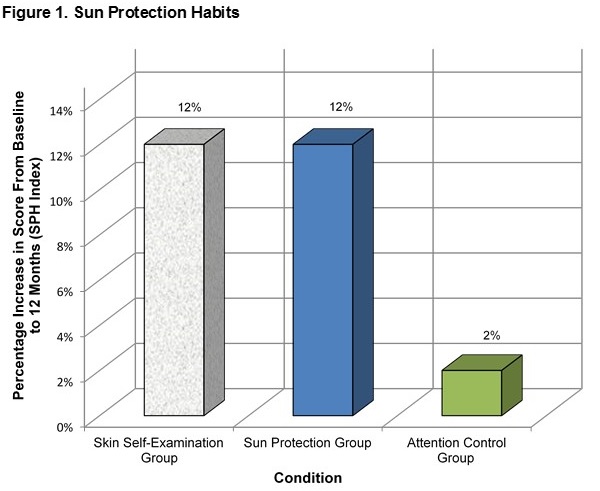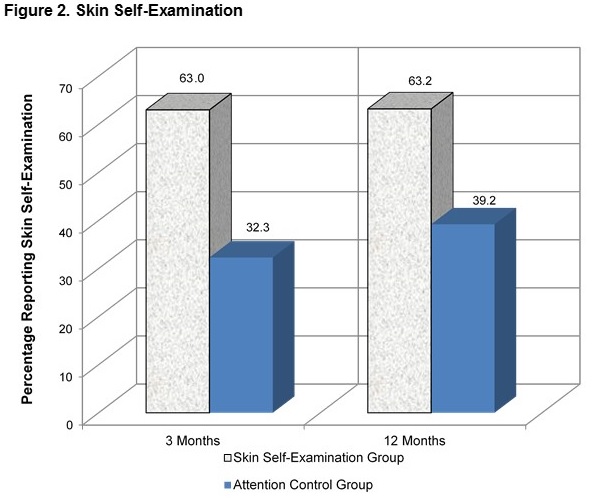The Implementation Guide is a resource for implementing this evidence-based program. It provides important information about the staffing and functions necessary for administering this program in the user's setting. Additionally, the steps needed to carry out the program, relevant program materials, and information for evaluating the program are included. The Implementation Guide can be viewed and downloaded on the Program Materials page.
Program Synopsis
Designed to prevent skin cancer through increased awareness and use of sun protection practices, this educational intervention consists of a baseline survey (to ask about skin cancer risk factors and other information) and a series of customized text messages that encourage participants to engage in sun protection habits and check their skin for signs of cancer. The study showed increases in sun protection habits and skin self-examination.
Program Highlights
Program Materials
Preview, download, or order free materials on a CD
Implementation Guide
Download Implementation Guide
Featured Profile
Learn more about this program and the developer who created it
Program Scores
The Need
Melanoma incidence rates vary widely across the world but are highest in countries with a large proportion of Caucasians and high ultraviolet radiation (UVR) such as Australia and New Zealand, where the age-standardized incidence is 40 per 100,000 men and 30 per 100,000 women. These rates are about twice those in the United States and Northern and Western Europe. Among Australians 15-44 years, melanoma is the most common cancer. Interventions that use text messages (messages sent via short message service, or SMS) to encourage sun safety behaviors and skin self-examination may decrease risks associated with skin cancer, particularly among people living in high UVR regions.
The Program
Healthy Texts is an educational intervention for adult men and women that aims to reduce the risks associated with skin cancer by increasing sun protection habits and skin self-examination. The intervention consists primarily of 21 text messages delivered to mobile phones over a 12-month period that encourage participants to engage in sun protection habits (e.g., wearing sunscreen, staying in the shade) and check their skin for signs of skin cancer. Based on social cognitive theory, the intervention aims to increase self-efficacy, build behavioral capacity, and guide outcome expectations.
The intervention begins with a baseline telephone survey that collects participant information used to customize the text messages. The messages are tailored using each participant's name, gender, skin cancer risk factors (e.g., skin color, eye color), number of times sunburnt, and previous performance of skin self-examinations. Text messages are then sent to participants once weekly for 12 weeks. Participants complete a 3-month follow-up telephone interview that is used to customize the text messages they receive monthly for 9 more months. At month 12, participants partake in a final telephone interview. Examples of text messages include, "[Participant name], melanoma rarely has symptoms so look out for the AC rule when checking your moles: Asymmetry (halves that differ) and more than one Color. HealthyTexts" and "[Participant name], it's great that you have thought about reducing your risk of skin cancer. Make this a reality by protection your skin from the sun when outdoors. HealthyTexts."
Time Required
-- 30 minutes to conduct telephone interviews at baseline, 3-month follow-up, and 12-month follow-up
-- 30 minutes to schedule and send each text message to multiple recipients using an automatic system
-- Each time a text message is sent to multiple recipients, 30 minutes to confirm that all messages were received and opened and to review any responses from participants
Intended Audience
The intervention is intended for adults aged 18‒42, particularly those living in high UVR regions.
Suitable Settings
The intervention is designed for use in community settings.
Required Resources
Required resources to implement the program include the following:
--SMS Schedule
--Baseline Interview Questions
--Mid-Program Interview Questions
--12-Month Interview Questions
--Sample Access Database Texting Platform (Screenshots)
For costs associated with this program, please contact the developer, Monika Janda. (See products page on the EBCCP website for developer contact information.)
About the Study
A randomized controlled study using two intervention groups and one control group was conducted to compare the impact of text messages on sun protection habits and skin self-examination. The intervention groups consisted of one group receiving text messages about sun protection habits and another group receiving messages about skin self-examination. The attention control group received text messages about physical activity. The study included participants aged 18‒42 who resided in Queensland, Australia. From January to May 2012, a random sample of 15,000 men and women from the Queensland electoral roll or Medicare register received a mailed invitation to participate in the study. Participants who did not understand English, did not own a mobile telephone, or had a history of melanoma were excluded.
From the mailed invitations, 678 (4.5%) indicated interest in participating in the study, 574 were eligible, and 546 completed the baseline telephone interview, and complete data were available for 512 participants at the end of the 12-month study. Of the 546 enrolled participants, 67% were females. Seventy-eight percent were born in Australia, 20% had very fair skin color, 46% had fair skin color, 20% had medium skin color, and 14% had olive skin color.
The study's primary outcomes, sun protection habits and skin self-examination, were measured through telephone interviews at baseline, 3-month follow-up, and 12-month follow-up. The adoption of sun protection behaviors was measured using the sun protection habits (SPH) index, a retrospective self-report scale. Participants rated their frequency of using six sun protective methods (wearing a shirt with sleeves, sunglasses, hat, or sunscreen; staying in the shade; and limiting time in the sun during midday hours) between 10:00 a.m. and 3:00 p.m. on a 4-point Likert scale from 1 (never/rarely) to 4 (always). For the skin self-examination outcome, participants were asked whether during the past 3 months and during the past 12 months someone who is not a doctor, such a spouse or partner, deliberately checked any part of the participant's skin for early signs of skin cancer. If so, a follow-up question gathered information about the frequency and thoroughness (any skin, part of body, or whole body) of the examinations. The three groups were similar in all baseline characteristics except one: the skin self-examination intervention group had a higher rate of past-year sun tanning than the two other groups.
Key Findings

- At 12 months, improvement in sun protection habits was significantly greater in the skin self-examination intervention group (p=.035) and sun protection intervention group (p=.030) than the attention control group. No differences between groups were found at 3 months.

- Compared with the attention control group, the skin self-examination intervention group reported significantly more self-examination of any skin at 3 months (p<.001) and 12 months (p<.001). There were no differences between the sun protection intervention group and the attention control group.
Other Findings
- No differences were found between groups in whole-body skin self-examination, sunburns in the past 12 months, or attempted suntan in the past 12 months.




